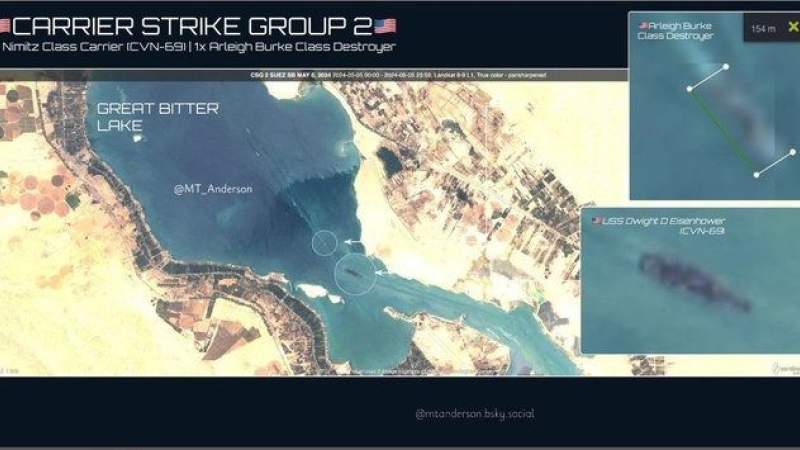A US Navy aircraft carrier is rearmed and back in the Red Sea amid a Houthi missile crisis with no end in sight
- Two US Navy warships on the front lines of the Houthi battle are back in the Red Sea.
- The USS Dwight D. Eisenhower and USS Gravely made a recent port visit in Greece.
- A Navy spokesperson confirmed that the two ships were resupplied and rearmed there.
The US Navy aircraft carrier that spent months battling the Houthis in the Red Sea is rearmed and back in the waterway after a short break. The warship's return comes as American intelligence officials warn the conflict may go on for a while.
The USS Dwight D. Eisenhower and Arleigh Burke-class guided-missile destroyer USS Gravely are back in the Red Sea to continue their maritime security mission after a recent port visit in Souda Bay, Greece, a Navy spokesperson confirmed to Business Insider on Tuesday.
US Naval Support Activity Souda Bay, located on the Mediterranean island of Crete, is a decades-old forward-operating station where American and NATO vessels can receive maintenance, cargo, food, fuel, supplies, and ammunition.
During the brief port visit, the two ships were resupplied and rearmed while their sailors enjoyed some relaxing downtime, the spokesperson said. It marked their first stop since their ongoing deployment began in mid-October.
USNI News first reported on Monday that the Eisenhower was back in the Red Sea.
Rear Adm. Marc Miguez, commander of the carrier strike group, said the sailors "have worked tirelessly for six months straight to keep us operating on station in the most challenging, dynamic combat environment the Navy has seen in decades."
"This port visit is well-deserved," Miguez said in a Navy statement after the Ike and Gravely left Souda Bay last week.
Last week, the US intelligence chief warned lawmakers that the Houthis are "going to remain active for some time," partly because they are domestically producing a lot of weaponry while also continuing to receive support from Iran.
"Neither of those things are likely to change in the near future," Director of National Intelligence Avril Haines told the Senate Committee on Armed Services during a hearing on global threats.
"That doesn't mean that the strikes that the Department of Defense and the coalition‚ with our allies, have taken haven't had impact," she said, referring to unilateral US strikes and joint strikes with the UK in Yemen. "They have," she added, "but it's been insufficient to really stop the Houthis from going down this road."
The Houthis have claimed that their attacks are directly related to Israel's ground offensive in the Gaza Strip, triggered by Hamas' Oct. 7 massacre, but US officials have pushed back on this, citing the wide range of nationalities that have been targeted at sea by the rebels.
Haines told lawmakers that it's unclear whether a cease-fire between Israel and Hamas would lead to a drop in Houthi activity.
While there may be no immediate end in sight to the Red Sea conflict, US officials have routinely stressed that American forces will continue to engage the Houthis.
Pentagon Press Secretary Air Force Maj. Gen. Pat Ryder told reporters last month that "as long as there continues to be a threat to international shipping and to the lives and safety of mariners transiting the Red Sea, we'll continue to work with international partners to degrade and disrupt Houthi capability."
US aircraft carrier returns to Red Sea amid ongoing Houthi attacks
Iran-backed Houthis carried out at least 140 attacks in the Red Sea and Gulf of Aden since Nov. 19, US official tells Al Arabiya English
The IKE has been at the forefront of an international coalition to confront Houthi attacks in the Red Sea and Gulf of Aden since the Iran-backed group started attacking merchant, commercial and military vessels in the aftermath of the Oct. 7 Hamas attack on Israel.
For the latest updates on the Israel-Palestine conflict, visit our dedicated page.
The aircraft carrier left the Red Sea and arrived in the Eastern Mediterranean after transiting through the Suez Canal on April 26. It then made its first public port call in Souda Bay, Crete, before returning to the Red Sea this week. A US defense official told Al Arabiya English that the IKE went to Crete for a quick resupply mission.
The Houthis have carried out at least 140 attacks in the Red Sea and Gulf of Aden since Nov. 19, the official said.
It remains unclear to the sailors and officers aboard the Eisenhower when they will be able to return home to the US, but Biden administration officials estimate early summer as a realistic timeframe for the strike group to return to Norfolk. However, the US will maintain a presence in the area, and it is expected that a different aircraft carrier will take over the responsibilities of the IKE in the next few weeks.
The Eisenhower, the flagship of Carrier Strike Group Two, has been deployed since Oct. 14, just days after the Hamas attack, which reignited fighting in a region that US President Joe Biden’s top national security advisor had said just a few days before was “quieter today than it has been in two decades now.”




No comments:
Post a Comment